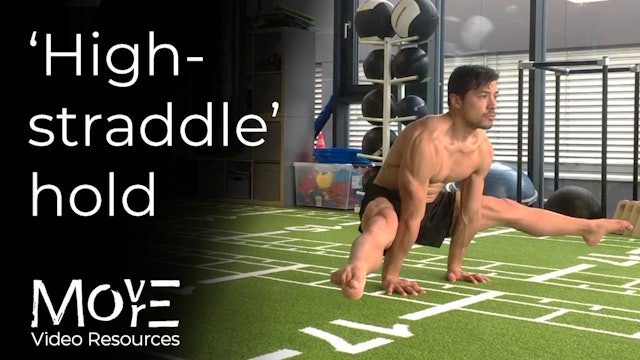'Compression' mobility-development
‘Compression’ describes the capacity to actively pull, or “compress”, the legs closer to the torso. As such, it is an innately ‘OPEN kinetic-chain’ context, meaning that the extremities doing the “work” (i.e. the leg/s) are free to move in space. Another perspective is of “closing the gap” between or “folding” the upper & lower-halves of the body together, which reminds us that, further to an effort to bring the LEGS closer to the BODY, it is simultaneously an effort to bring the BODY closer to the LEGS (the definition of “compression” supposes that there is force produced from BOTH sides, causing something in the middle to be COMPRESSED).
At the same time, it is also important to consider that “compression” does not only take place in the sagittal-plane in “forward-folding” execution, but can also occur sagittally to the back as well as in the frontal-plane (i.e. leg abducted high to the sides) and everything in between. This is represented in the likes of the standing, unilateral ‘Arc & reach’ variations as well as the ‘Low-gait meia-lua’ context, both which expresses & develop compression from front-to-back through 180° of transverse range.
LEARN MORE (subscriber-only):
https://drive.google.com/file/d/1akwRVZ7nLeuXM-LQR6B_YAHoiER8kgUT/view?usp=drive_link
-
Low-gait 'meia lua'
THE WHAT:
At the lowest-of-the-'low-gait' contexts sits the maximally-compressed squat form, from which any lower in space must be a transition into the floor. 'Low-gait balance contexts' (namely unilateral), then, carry both the valuable experience of unilateral lower-body practice context as we... -
Single-leg 'Arc, reach, & Hip-open'
THE WHAT:
The 'Arc & Reach' is an integrated unilateral-stability & range-development context. It is comprised of a standing compression 'Arc' (pulling the STRAIGHT leg as HIGH as possible in the sagittal plane & drawing a half-circle to the back) & a unilateral, straight-leg 'hinge' pattern (the... -
L-sit to V-sit progression
THE WHAT & HOW:
'THE L-SIT' represents another fundamental bodyweight-strength (BWS) form whereby the load of the body in its entirety is held off of the floor. That it begins in a seated position and utilises a scapular pushing mechanic with much greater "real-world" application than other BWS f... -
High straddle-hold
THE WHAT:
An integrated straddle-compression (i.e. active lifting of the extended legs) and straight-arm scapular-strength (SASS) drill in the context of vertical pushing. Ultimately, these two aspects integrate into a fundamental isometric form which both serves for strength-conditioning and 'ac... -
Travelling Straddle (forward & back)
THE WHAT & HOW:
A quadrupedal locomotion pattern progressing from the 'Travelling Squat', toward functioning as both a straddle-conditioning (dynamic compression) and straight-arm scapular-strength/SASS (sustaining the weight of the body in the arms) development tool.LEARN MORE (subscriber-only...
-
Compression routine 1.0
THE WHAT:
"Compression" is ultimately the ACTIVE pulling together of your top & bottom-halves into a front-folded position. The two main front-folded positions are 'pike' (legs together) and 'straddle' (legs apart), and so we are essentially working to pull the LEGS toward the body whilst simulta... -
Unilateral straddle compression
THE WHAT & HOW:
A straddle-compression routine which allows for greater focus (i.e. concentrated contractions) by working 1 leg at a time, and can be practiced at any stage of compressional development.LEARN MORE (subscriber-only):
https://drive.google.com/file/d/1qYI74wSciDHEl492tsSGUCpmq10sa... -
Full-range straddle compression
THE WHAT & HOW:
A developmental straddle-compression routine, ideally practiced only once a fundamental level of straddle front-folding (i.e. 'Pancake' form) has been developed.LEARN MORE (subscriber-only):
https://drive.google.com/file/d/1Kotofhfs0u6JuA76qek7jCfivSQhzBtE/view?usp=drive_link...
-
V-sit pike compression
THE WHAT & HOW:
A no-fuss, straight-to-the-point pike-compression routine inspired by the training of 6-year-old female gymnasts (literally). Performed predominantly in the piked end-range, it brings more focus to the abdominal-aspect of compression toward development of the 'V-sit' form.LEARN...
-
Pike compression 2.0 (L-sit focus)
THE WHAT & HOW:
Another no-fuss, straight-to-the-point pike-compression routine inspired by the training of 6-year-old female gymnasts (literally). Performed predominantly in the more "open" range of L-sit, it incorporates straight-arm-strength toward improving both elevation & compression potent... -
The 'Kneeling lean-back'
THE WHAT:
An isometric-emphasis context focused on patterning & strengthening the "open-hip" angle (i.e. maximal hip-extension), whilst under increasing bodyweight load (the deeper you "lean" backward, the "heavier" the context gets).In this way it shares similarities in loading with the fundam...
-
Quadriceps & hip-flexor stretches
THE WHAT:
Fundamental static stretches affecting the "hip-flexors" & quadriceps complex. Whist incomplete in themselves for developing sustainable and USABLE ranges in the long-term, their convenience allows them to be more easily cultivated into an habitual daily practice, one of the most powerf... -
Walking front & back sagittal-kicks
THE WHAT:
A bipedal, locomotion-conditioning context which expresses & develops the elasticity of the legs (both posterior & anterior-chain) through the practice of walking kicks, in the sagittal plane.___________________
For programming, guidance, & support for your physical practice:The 'Vi...
-
'Single-leg (SL) reach' progressive variations
THE WHAT:
Time to inject some "noise" into the fundamental unilaterally-hinging 'Reach' form, with an eye toward furthering structural, kinaesthetic & proprioceptive awareness, responsiveness, and general adaptability in the ongoing cultivation of movement 'dexterity'. On the physical layer, mobi... -
Single-leg (SL) 'Figure-8' (F8) / 3-levels
THE WHAT:
A most fundamental single-leg (SL) balance context in which the universal 'figure-8' (F8) is used as a frame to develop patterning, proprioception, and structural adaptability on one leg. As a 'side-effect', the process of practice will also develop physiological capacities toward impro...

















